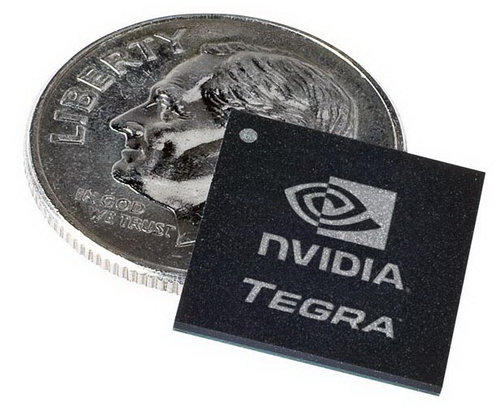Tegra, CUDA Powering CPU/GPU Hybrid Supercomputer
The Barcelona Supercomputing Center plans to build a system using Nvidia's Tegra SoC and CUDA GPU to reduce the enormous power consumption supercomputers typically need.

On Tuesday, the Barcelona Supercomputing Center (BSC), a government funded research center in Spain, revealed plans (pdf) to build the world's first ARM-based CPU/GPU hybrid supercomputer using Nvidia's Tegra ARM-based SoC and a CUDA GPU installed on a hardware board designed by SECO. The hybrid supercomputer will be used to accelerate a variety of scientific research projects.
"Supercomputers are becoming increasingly capped by power," Nvidia's Sumit Gupta said in a blog. "Extreme scale supercomputers (petascale, exascale) are required for advancing science and technology, but the power consumption of these systems has already reached the 10 megawatt to 20 megawatt range. This means one of today’s larger supercomputers will use as much power as a small town. This rate of power consumption is not sustainable."
To prevent this type of insane power consumption, BSC said it will develop a large scale system that is two to five times more energy-efficient than current Intel and AMD-based x86 solutions while also delivering exascale-level performance. This will be accomplished by using the Nvidia CUDA GPU to accelerate supercomputing applications running on the Tegra processor.
"In their search for more energy efficient architectures in supercomputers, BSC concluded that typical x86-based CPUs in today’s supercomputers consume up to 40 percent of the system’s total power," Gupta added. "They’ve also realized that ARM CPUs are much more energy-efficient than x86 CPUs from Intel and AMD."
In conjunction with the BSC announcement, Nvidia said that it plans to release a new hardware and software development kit for similar ARM-based initiatives. The kit will include hardware developed by SECO, and a quad-core Tegra 3 accelerated by a discrete Nvidia GPU. The kit will be supported by the CUDA parallel programming toolkit and released in the first half of 2012.
BSC is currently showing its hybrid supercomputer system design publicly for the first time at this week's SC11 Conference, which runs Nov. 14-17 in Seattle, Wash., in exhibit booth #235.
Get Tom's Hardware's best news and in-depth reviews, straight to your inbox.

Kevin Parrish has over a decade of experience as a writer, editor, and product tester. His work focused on computer hardware, networking equipment, smartphones, tablets, gaming consoles, and other internet-connected devices. His work has appeared in Tom's Hardware, Tom's Guide, Maximum PC, Digital Trends, Android Authority, How-To Geek, Lifewire, and others.
-
alyoshka "This rate of power consumption is not sustainable." .... Hmm Interesting, some had the guts to say that....Reply -
aldaia I personally know this group and even had one of the boards in my hands a few weeks ago, when everything was still secret. The concept is technically sound. Once they install the GPU's they expect to reach 7.5 GFLOPS / W this is almost 10 times more efficient than the K-supercomputer which achieves 800 MFlops /W. The top 1 in the green 500 list (pending the November update) is an IBM prototype achieving 2 Gflops/WReply
Despite denying it publicly, Intel actually fears the ARM revolution. Maybe this is the reason why, the same day that the ARM supercomputer prototype is disclosed in Seattle, in Barcelona we have this other news:
"BARCELONA, November 16, 2011 –Today, Intel Corporation and the Barcelona Supercomputing Center (BSC) have signed a multi-year agreement to create the Intel and BSC Exascale Laboratory in Barcelona. The new lab will be located at the premises of BSC and focus on software and extraordinary levels of parallelism which will be needed to utilize future Intel-architecture based supercomputers. Exascale supercomputers will deliver up to 1,000 times the performance of today’s fastest systems using as many as 100 million processor cores to do so." -
saturnus aldaia"BARCELONA, November 16, 2011 –... using as many as 100 million processor cores to do so."Reply
Oh my. If those are i7 based cores then we're talking 4-5 Gigawatt of power consumption.
I never knew that supercomputers could go into thermonuclear meltdown. -
lockhrt999 Great now sometime in future I can say, that supercomputer is running on my mobile's processor.Reply -
saturnus mcd023what is the performance per clock comparison btwn ARM and x86?Reply
Next generation ARMv8 will be between 60-80% of i7 performance per core per clock. At about 5% (that's right 1/20th) the power consumption. -
nhat11 saturnusNext generation ARMv8 will be between 60-80% of i7 performance per core per clock. At about 5% (that's right 1/20th) the power consumption.Reply
Eh you might want to reference that to something otherwise it just seems like smoke -
saturnus nhat11Eh you might want to reference that to something otherwise it just seems like smokeReply
Sure. This is first generation ARMv8, for next generation ARMv8 head over to ARM's website to see projections. -
tmk221 saturnusNext generation ARMv8 will be between 60-80% of i7 performance per core per clock. At about 5% (that's right 1/20th) the power consumption.Reply
hahahahaahahahahahhahahahahahahahahhahahahahahhahahahhahahahahahhahahahahahahhahahahahahahahahhhahhahahahahahahahhahaahahahhahahahahhahahahahahahhahahahhahahahahahahahahahhahahahahhahahahahahahahahhaahahhahahahahahahahahahahahaahahhahahahahahahahahahahhahaha
in your dreams -
doron saturnusSure. This is first generation ARMv8, for next generation ARMv8 head over to ARM's website to see projections.Reply
You might wanna read that again... It's not a per-core comparison.